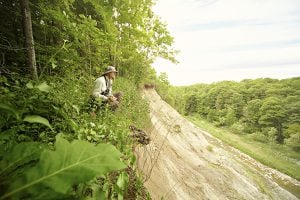After clinging to the coastline for several kilometres, the trail transitions into Le Grand Tour before diverging back into the forest. Some portions of this trail are along another expansive beach, Anse à Moulle-Cul. This section of the trail will bring complete satisfaction if you appreciate the smell of salty air, cool winds and being immersed in nature. The looming threat of encroaching tides has passed, and from here on out, you can enjoy a more typical hike. Just keep your eye out for the signage indicating the transition of the trail into the woods; otherwise, you will be stuck walking around the perimeter of the peninsula for several kilometres.
In the woods, the sound of crashing waves subsides and peace reigns, with a shady walk through a pine-dominated forest. Continue for about two kilometres until you reach a sign indicating that you have reached Le Scoggan, a seven-kilometre trail through the woods. Keep your eyes out for deer, foxes and the occasional porcupine.
If you are not too tired, there is an option to deviate from Le Scoggan to Le Parcours La Pinède, a 5.8-kilometre trail through century-old jackpines to two magnificent lookouts. This hike is predominantly uphill, but the view is definitely worth it. Unfortunately, La Pinède does not transition into another trail, so you must backtrack to Le Scoggan before continuing your hike.














